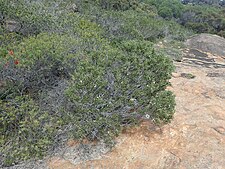Hakea clavata
| Coastal hakea | |
|---|---|

| |
| In the Cape Le Grand National Park | |
| Scientific classification | |
| Kingdom: | Plantae |
| Clade: | Tracheophytes |
| Clade: | Angiosperms |
| Clade: | Eudicots |
| Order: | Proteales |
| Family: | Proteaceae |
| Genus: | Hakea |
| Species: | H. clavata
|
| Binomial name | |
| Hakea clavata | |

| |
| Occurrence data from AVH | |
Hakea clavata, commonly known as coastal hakea[2] is a shrub that is endemic to an area along the south coast of Western Australia. It has thick leaves, pink and grey flowers and grows on rocky outcrops.

Description
[edit]Hakea clavata is a lignotuberous spreading or sprawling shrub up to 2.5 metres (8 ft) wide and 0.5 to 2.0 m (1.6 to 6.6 ft) high. Mid-green leaves are thick, flattened, long and narrow 2 to 8 centimetres (0.8 to 3.1 in) long and 4 to 11 millimetres (0.157 to 0.433 in) wide, ending in a hard sharp point. Sometimes club-shaped widening at the apex. The inflorescence has 60-80 white and pink flowers appearing in short racemes in leaf axils and tips of branches. The perianth has a pink claw, grey limbs and white interior. Woody fruit are egg-shaped with the widest part nearer the stem 1.5 to 2.5 cm (0.59 to 0.98 in) long and 0.9 to 1.0 cm (0.35 to 0.39 in) wide. Alternatively egg-shaped with the wider section toward the apex, both shapes having two small horns at the back of the fruit. The black-brown seeds have an obliquely obovate shape and a length of 16 mm (0.630 in). Each seed has a broad wing along one side of seed body.[3][4][5]
Taxonomy
[edit]Hakea clavata was first formally described in 1805 by Jacques Labillardière in Novae Hollandiae plantarum specimen. Labillardière may have made a type collection when at the Esperance region in December 1792.[6] The specific epithet (clavata) is derived from the Latin word clava meaning "club",[7] referring to the club-shape of the leaves.[3]
Distribution
[edit]Coastal hakea is found on the mainland and on some of the islands between Israelite Bay and Esperance and a single population is known at Hopetoun to the west.[3] The range covers southeastern areas of the Southwest Botanical Province. The species grows in rocky sandy clay soils among granite outcrops and withstands salt laden winds.[8]
References
[edit]- ^ "Hakea clavata". APNI. Retrieved 23 January 2019.
- ^ Holliday, Ivan. "Hakeas a Field and Garden Guide". Reed New Holland. ISBN 0-9585778-2-X.
- ^ a b c "Hakea clavata". Fact Sheet. Government of South Australia. Retrieved 11 October 2018.
- ^ Barker, Robyn M; Haegi, Laurence A.R.; Barker, William R. "Hakea clavata". Flora of Australia. Australian Biological Resources Study, Department of Climate Change, Energy, the Environment and Water: Canberra. Retrieved 6 July 2024.
- ^ Archer, William. "Coastal hakea - Hakea clavata". Esperance Wildflowers. Retrieved 17 October 2018.
- ^ Hopper, Stephen (2003). "South-western Australia, Cinderella of the world's temperate floristic regions 1". Curtis's Botanical Magazine. 21 (2): 132–179. doi:10.1111/1467-8748.00380.
- ^ Brown, Roland Wilbur (1956). The Composition of Scientific Words. Washington, D.C.: Smithsonian Institution Press. p. 231.
- ^ "Hakea clavata Labill". FloraBase. Western Australian Government Department of Biodiversity, Conservation and Attractions.
